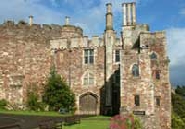Archaeologists from Bristol University have added 1,000 years of history to Berkeley Castle by uncovering remains of an Iron Age settlement.
The unexpected discovery was made in the kitchen gardens of the castle during a training excavation for Bristol students. Parts of a ring ditch that might have circled a house, prehistoric flint tools, and a few fragments of human bone have been found immediately below the Victorian flower beds and greenhouses.
Berkeley Castle is one of the most historic places in Gloucestershire, still inhabited and owned by the same family who were granted the castle in 1156. Throughout the Middle Ages, the castle played a important and colourful role in both local and national politics. However the early history of the site remain mysterious, and uncovering this was the target of Bristol University's research.
Dr Mark Horton, Head of the Department of Archaeology and Anthropology who is leading the investigations, said: "We know that there was an Anglo-Saxon abbey close to the site of the castle, but to find prehistoric remains is an exciting and unexpected discovery.
"Very few prehistoric burials are known in the Severn Vale, and most are found on the Cotswolds Hills. It is possible that this settlement was located on a small ridge of high ground, to be visible from the river Severn, and might even had been located to help prehistoric navigation up the Berkeley Pill."
The investigations have been undertaken by first year students studying archaeology at the University, and will be continued in July by aspiring archaeologists who are still at school and want to find out what it is like to work on a dig. The excavations will be filled in shortly, but it is hoped that there will be a display on the discoveries at the castle for visitors.